Last Updated on March 11, 2024
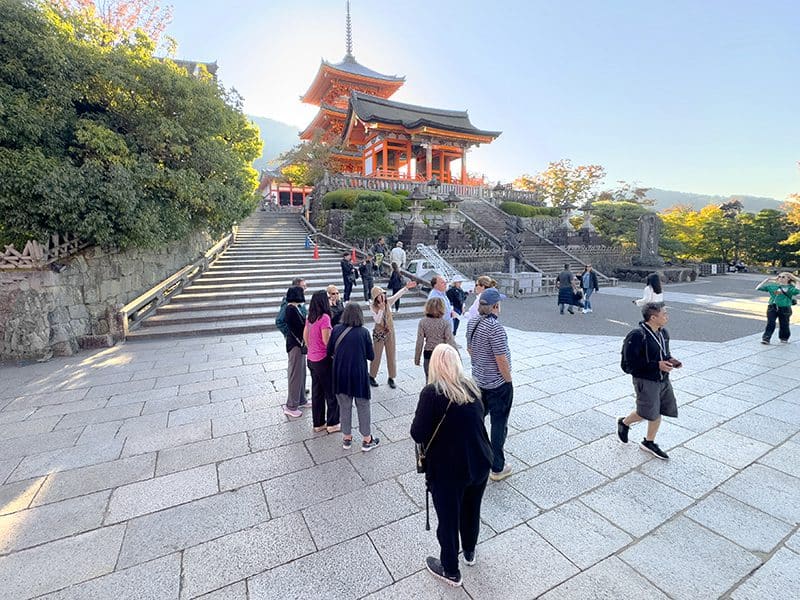
By Jim Ferri and Marjorie Kean
Estimated reading time: 19 minutes
While Tokyo may be the essence of modern Japan, Kyoto is undoubtedly the epitome of its past.
In fact, you can’t help but see the roots of ancient Japan just about everywhere you turn. It’s a city world-renowned for its culture, as well as its dining and charm.
You can’t ignore the fact that Tokyo has its charisma as well. But Tokyo’s charisma makes it renowned as a city of neon, crowds, raucous nightspots, and modern skyscrapers.
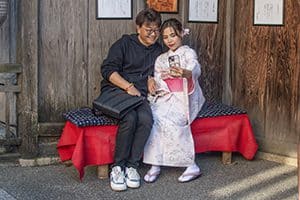
Come to Kyoto, and you instead find a city of kimonos and tea ceremonies, geishas, and quiet lanes with ancient wooden houses. And it has more ancient temples and shrines than you can see in a year of traveling.
On top of it all, Kyoto is home to 17 incredible UNESCO World Heritage Sites. On the other hand, Tokyo has two, and the rest of the country has four.
Come visit Japan, and you’ll quickly realize that while Tokyo may be the commercial brain of Japan, Kyoto is its cultural heart. It’s a city with a population of 1.5 million that attracts 50 million visitors a year.
Interestingly, part of the reason for Japanese culture’s survival in Kyoto is that there are fewer earthquakes in Kyoto than in other cities. In addition, Kyoto was the only major Japanese city not bombed in World War II.
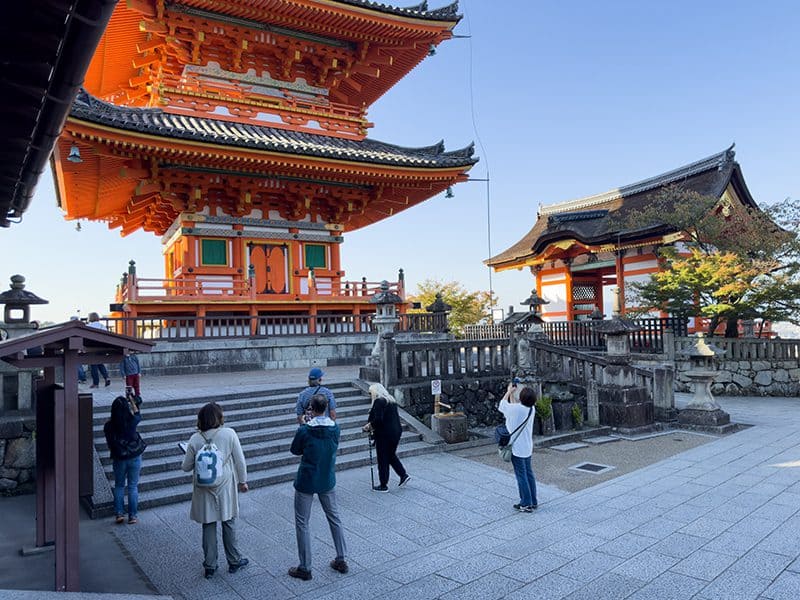
Things to Do In Kyoto: See Its Temples and Shrines
Kyoto has an incredible number of temples (1600) and shrines (800). Most of us, however, don’t know the difference between a temple and a shrine, although we’re all welcome at both.
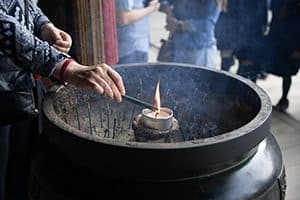
Simply explained, Japan has two dominant religions: Shintoism and Buddhism. (Interestingly, many Japanese practice both.)
Shrines are part of the Shinto religious tradition and have an entrance with a torii gate. The torii is the traditional red Japanese gate that marks the transition from the everyday to the sacred.
Temples are part of the Buddhist religious tradition and have a “sanmon gate” at the entrance. This gate is usually not red and is part of the group of buildings that form the temple.
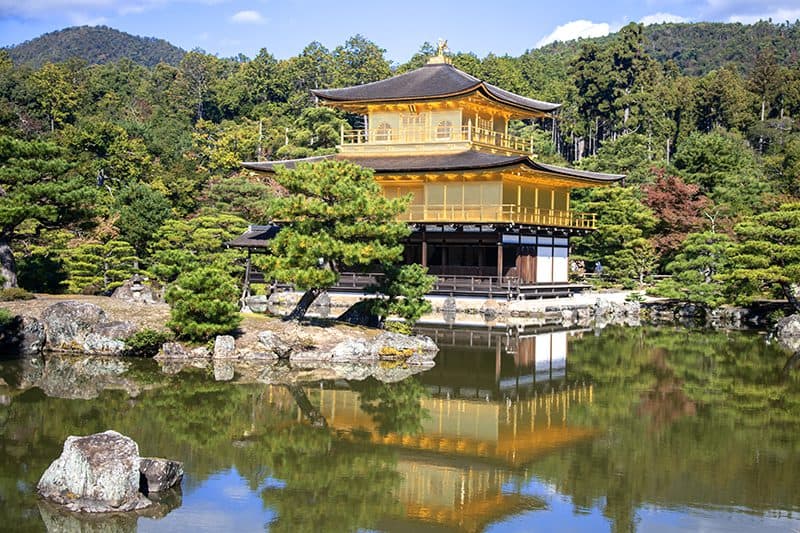
Kyoto Kinkaku-Ji (Golden Pavilion)
A UNESCO world heritage site, Kinkaku-Ji is part of the legacy of medieval Japan. Built in 1397 as the retirement home of a shogun, he directed it to become a temple after his death. In ancient Japan, shoguns were powerful military leaders.
Two floors of the three-story temple are covered in gold leaf; hence, it’s called the Golden Pavilion. It’s in a beautiful lake and garden setting, reached on a short stroll through the woods and temple garden.
However, the building you see is not the original, which was destroyed by fire in 1950, but an exact replica constructed in 1955. It’s beautiful in the early morning as its reflection glimmers in the serene water of the lake.
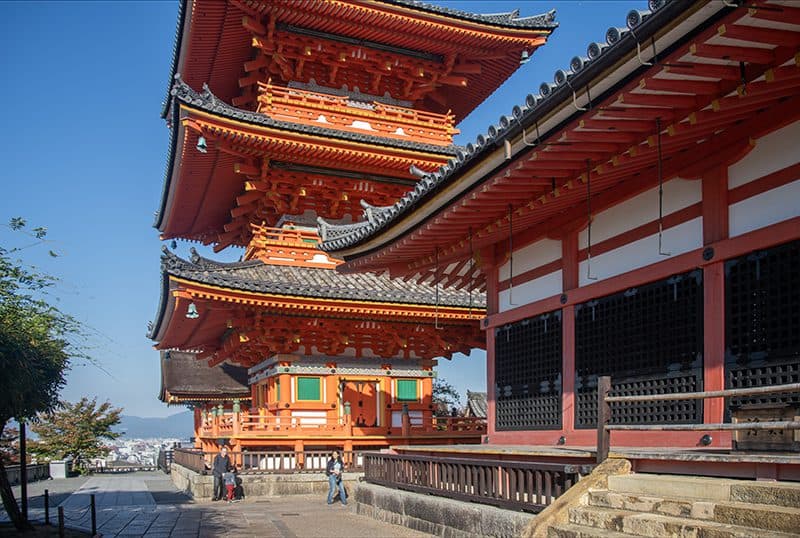
Kiyomizu-Dera
You reach Kiyomizu-dera, walking up from the Golden Pavillion (mostly uphill).
We both loved it…as we suspect did many of the others in the crowds visiting the same day. But it’s worth visiting anyway since the crowds don’t seem so significant when you’re in the beautiful forest. And you’ll likely find, as we did, that Kiyomizu-dera is a different experience.
While other religious buildings belong to Shintos or Buddists, Kiyomizu-dera feels it belongs to everyone. It is a Buddhist temple unlike any others in Kyoto – a clutch of religious buildings scattered about a mountainside. And it’s in a stunning setting. For starters, just step out on the wooden stage of the temple for an incredible view of Kyoto below.
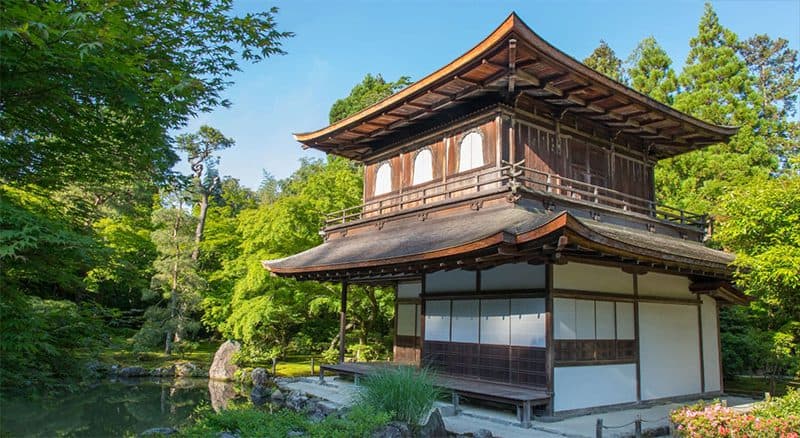
Ginkaku-ji Temple (Silver Pavilion)
The Higashiyama District in eastern Kyoto is among the city’s best-preserved historic districts. The Silver Pavilion is considered the center of what has come to be called “Higashiyama culture.” This segment of Japanese culture is renowned for its innovations in Japanese architecture, visual arts, and theater during the 15th century.
Although the temple was built by the ruling shogun then, it was never covered in silver as initially intended. Today, it is one of Kyoto’s UNESCO World Heritage sites, renowned for its temple garden.
Note: Shoes must be removed at temples and shrines, so always wear socks. Entrance fees at shrines and temples are cash only.
Yasaka Pagoda
The Yasaka Pagoda is a Buddhist pagoda located in Higashiyama. The only remaining structure of the 6th-century Hōkan Temple complex, you’ll find it near the Park Hyatt Kyoto Hotel.
To reach the pagoda from the shopping area of Ryōma Hill, a historical landmark, walk down the hill’s steps to the pedestrian-only Ryozan Shoboji Road. The road is lined with picturesque old shops, and you’ll see the pagoda straight ahead. The street is one of our favorite places in Kyoto, and it’s a good spot for photos.
If you can’t find your way to the pagoda, when you get to the end of the road (just a few minutes), turn right, walk to the Park Hyatt Kyoto Hotel (immediately on the right), and ask for directions.
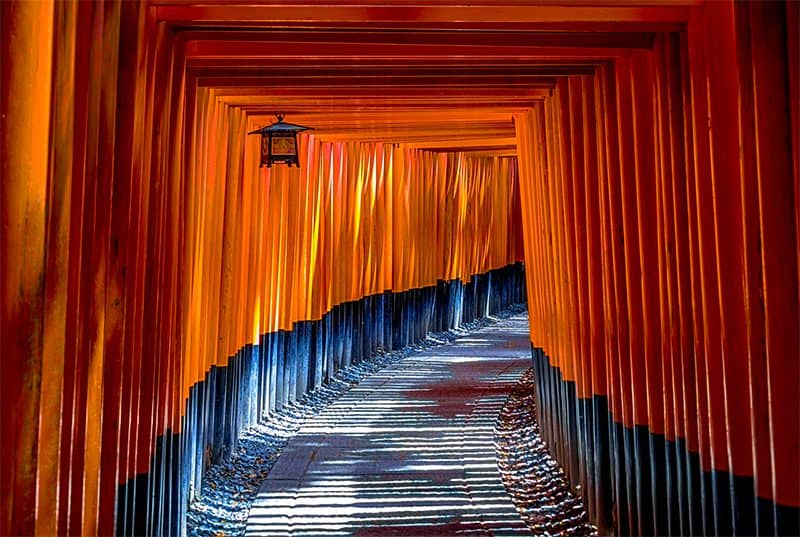
Fushimi Inari-Taisha (Shrine of the Thousand Torii Gates)
Predating the founding of Kyoto, the shrine is located in the ward of Fushimi meaning “hidden water.” With thousands of vermillion torii along a mountainside trail, it’s dedicated to Inari, the God of Rice and Sake.
Each of the Torri that line the 2½ mile (4 km) long trail was donated by an individual or company. It’s reported that the more enormous gates can cost as much as ¥1 million to dedicate. Most impressive is the gargantuan Romon gate by the main shrine. It was donated in 1589 by the warlord responsible for the unification of Japan.
It’s open 24 hours a day.
Other Things To Do in Kyoto
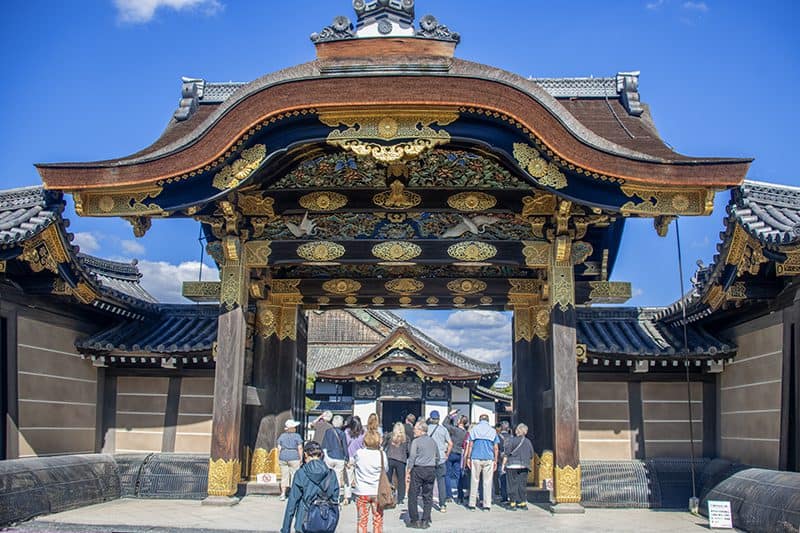
Visit Nijo Castle
Another popular thing to do in Kyoto is to visit Nijo Castle, the residence of a 17th-century shogun.
We felt, however, this UNESCO World Heritage Site looks slightly droll since it lacks the fortifications you’d expect for a castle. In fact, it seems more like a temple than a castle, although it does have thick stone walls and is encircled by a moat.
Inside, we found “nightingale” floors and beautiful murals. The floors are so named since they were designed to warn of intruders by making bird-like sounds when walked upon. The beautiful murals in the reception halls are the most significant works ever executed by renowned Japanese 15th-century-artist Kanō Mitsunobu.
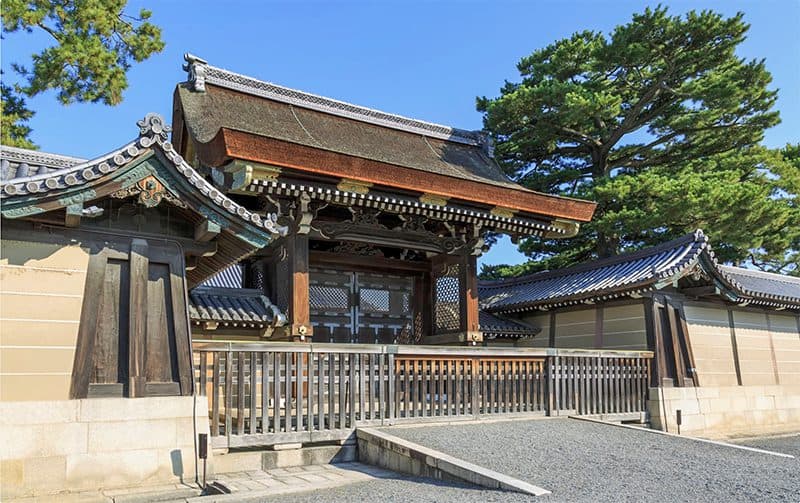
See the Imperial Palace
About a 20-minute walk from the castle is the Kyoto Imperial Palace. It was the residence of the Imperial family from 794 to 1868, when Kyoto was the capital of Japan.
Although the palace isn’t always open to the public, you can view its exterior and gardens from Kyoto Imperial Park.
For a few days during spring and autumn, however, you can enter the palace without a reservation or as a tour group member. You must, however, speak with your hotel concierge for specific information on dates and times.
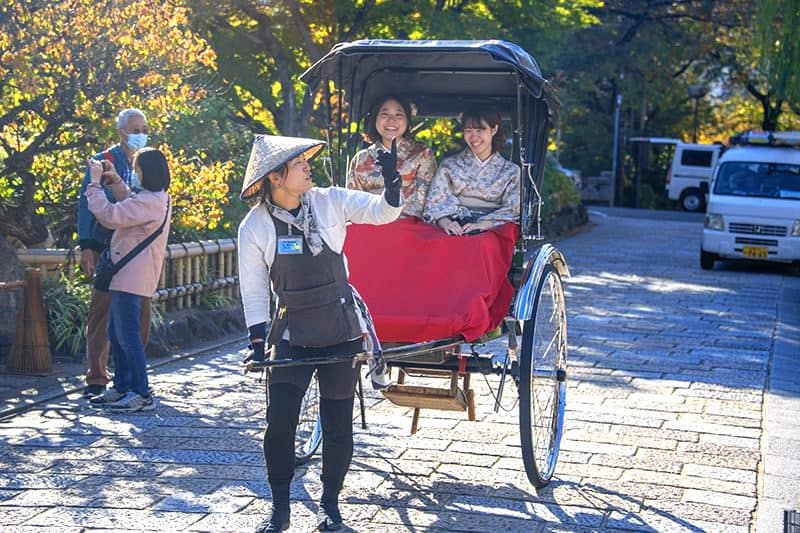
Wander About Gion and Higashiyama
Gion and Higashiyama are the adjacent wards (districts) that contain the sights and experiences that lure most people to Kyoto. It’s a very walkable area, and you’ll likely spend a fair amount of time here during a visit to Kyoto.
In Gion, the old wooden teahouses (ochaya) serve as residences and/or reception venues for geisha. As you might expect, some have now become high-end restaurants and bars.
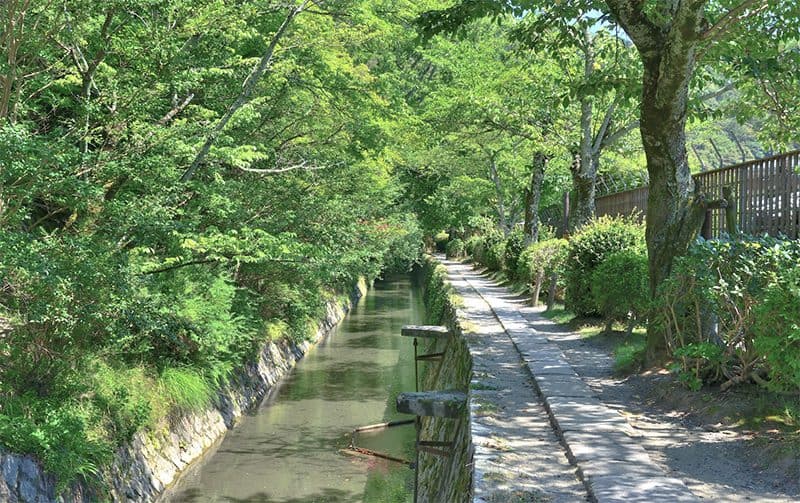
Stroll Along the Philosophers Walk
The Philosophers Walk, a narrow path alongside a canal, is named for a philosophy professor at Kyoto University. The professor used to walk along the pathway as part of his daily meditation. People today enjoy it for its natural beauty, especially during cherry blossom time (when it can get very crowded).
It begins near the Silver Pavilion (Ginkakuji Temple). You’ll pass several temples before reaching the Nanzenji Temple complex, once Japan’s most important temple. At the complex, you may recognize its enormous Sanmon Gate from the movie “Lost in Translation.”
Be aware that the path is a mile (.6km) in each direction with many steps. Also, transportation in the area may be challenging to find.
Another Thing to Do In Kyoto: Take a Cooking Class
If you enjoy Japanese food, why not take a cooking class in Kyoto? We took an introductory sushi-making class at our hotel. It was basic, less than an hour long, but it taught us how to make good sushi at home. We never knew what to do to prepare the rice correctly for sushi.
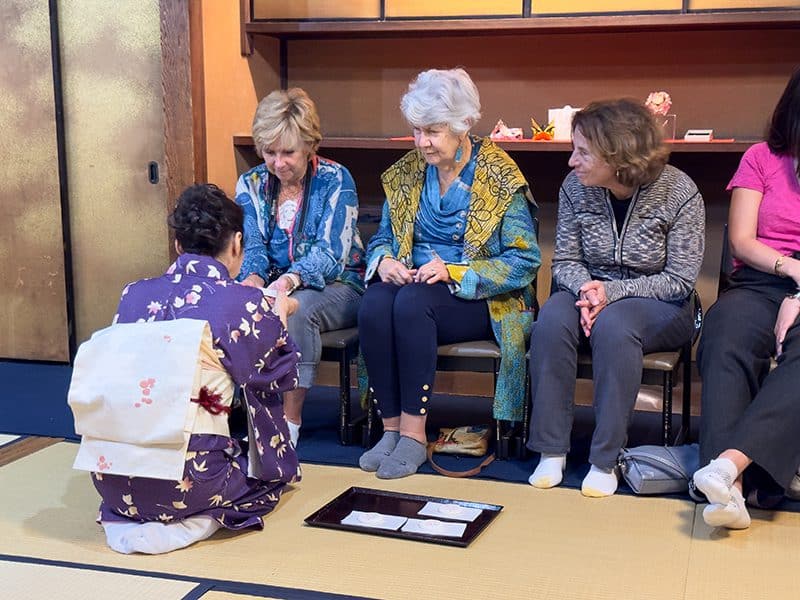
Attend a Tea Ceremony
Tea Ceremonies in Japan are quiet meditative events that often take place in Tatami-mat rooms. They are quiet affairs in which the only voice is that of the hostess as she mixes and serves the slightly bitter matcha tea, a green tea powder made from finely powdered dried tea leaves.
When you arrive, wait for your hostess to tell you where to sit or kneel. Also, follow her instructions about slurping up the bottom of your cup, which you hold so any picture on it faces your hostess. Both are considered good manners in Japan.
We attended our ceremony in a private home, including an origami lesson. There are several Kyoto tea houses around the city.
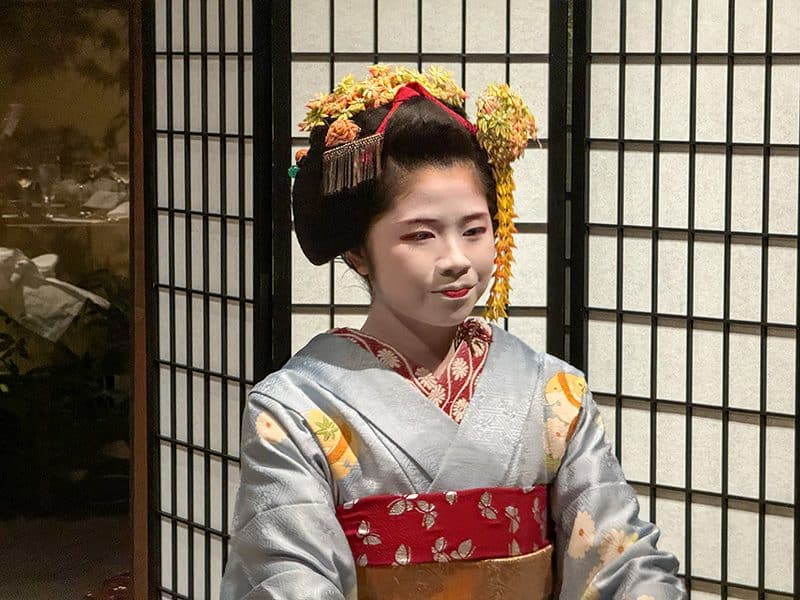
Geishas in Kyoto
Kyoto has Japan’s highest concentration of geishas (called geiko in Kyoto), although they now number only approximately 200. Apprentice geishas are called “maikos.”
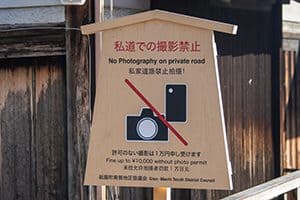
In Kyoto, your best opportunity to see a geisha is in the narrow alleys of the historic Gion District, home to many of the city’s geishas. The best time is 5:30–6:00 pm when they are walking to their evening appointments.
Be aware, however, that several streets in the area are private. Although you may walk about them, you may not take photos in the neighborhood. You’ll see “No Photos” signs and the penalty for taking pictures is ¥10,000 (about $68). You can blame this ban on the conduct of tourists in the past, some of whom have not asked a geisha’s permission to take photos and have even chased them.
Beware also that some (at times, many) of the geishas you see on the streets of Kyoto are actually tourists who have been to kimono renting services and have had a quick makeover.
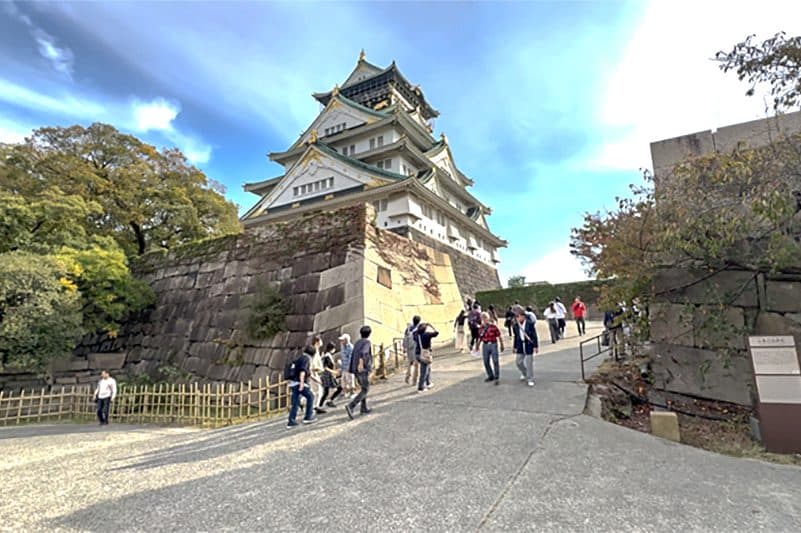
More Things to Do in Kyoto: Take Day Trips for Great Experiences
One of the smart things to do in Kyoto is to use the city as a base for taking day trips to other cities.
Kobe is 30 minutes away, and Nagoya 45 minutes. Osaka, a great foodie city, is only 15 minutes away, so close that some Kyotoites commute to Osaka for their jobs. My wife as surprised at what a charming and lovely city Osaka was.
Tranquil and beautiful Nara city is well worth the 40-minute train ride from Kyoto. For a unique experience, feed its deer, which will bow to elicit a treat from you. And don’t miss the Todai-Ji Temple with its 53-foot (16m) bronze Buddha, the largest in the world.
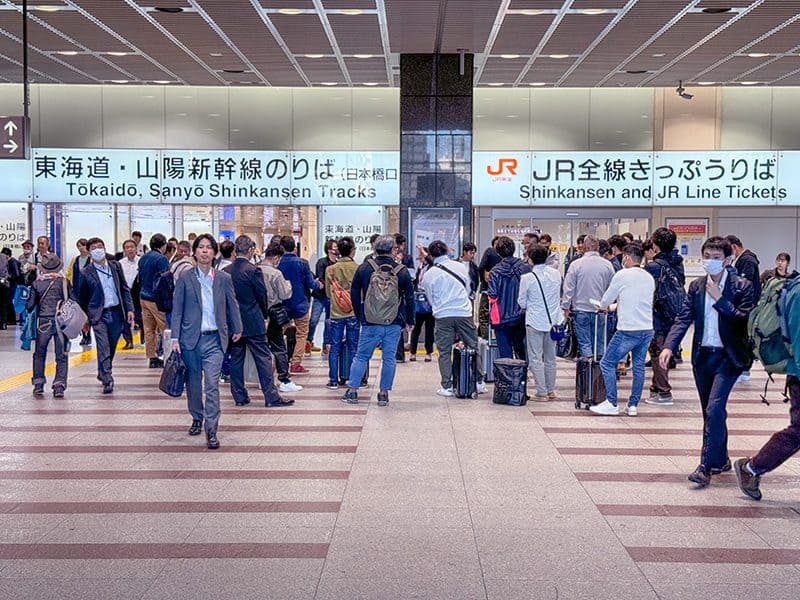
What Language Barrier?
You won’t find much of a language barrier in Kyoto, or in much of Japan, for that matter. Many street signs and other directional signs (on highways, airports, train stations, and trains, for example) are in Japanese and English. In addition, many young people speak a little English and are happy to practice their language skills on you.
In addition – and you’ll love this – the phone app Google Translate is like carrying your own personal translator in your pocket with access to 112 languages.
Say anything in any of the many languages it recognizes and it instantly translates it into Japanese or another language you choose. Then, just show your phone to someone, and they can reply to your phone, which will translate it into English for you. You can also take a photo of a sign, menu, etc., and it will translate it for you.
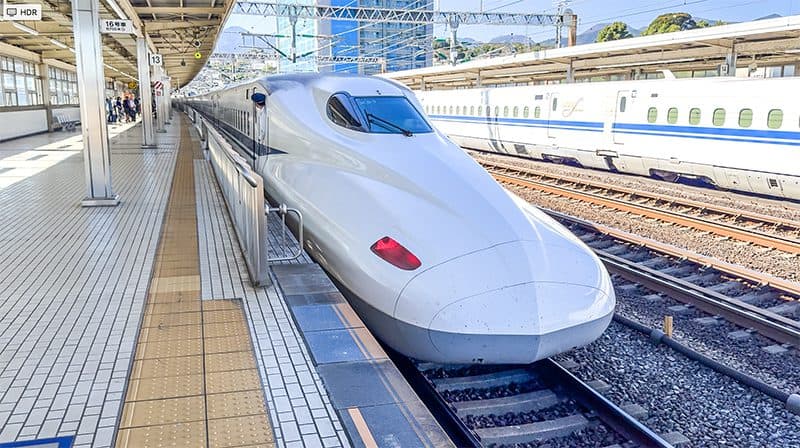
How to Get There: Tokyo – Kyoto By Train
Since Kyoto has no airport, the best way to get from Tokyo to Kyoto is on the famously fast Shinkansen bullet train. It reaches speeds up to 200 mph and is very comfortable, quiet, and exceptionally punctual. The trip takes approximately two hours and 20 minutes.
How to Get There: Tokyo – Kyoto By Train
Since Kyoto has no airport, the best way to get from Tokyo to Kyoto is on the famously fast Shinkansen bullet train. It reaches speeds up to 200 mph and is very comfortable, quiet, and exceptionally punctual. The trip takes approximately two hours and 20 minutes.
If you’re traveling from Haneda Airport or Narita Airport, it will take an additional 20 minutes or one hour, respectively. From Kansai International Airport, the Haruka Express whisks you into Kyoto Station in approximately one hour and 15 minutes.
You can take a bullet train to Kyoto from many major cities in Japan. It arrives at Kyoto Station, the hub for almost all city trains.
By the way, Kyoto Station is not only the gateway to Kyoto but a destination in its own right. The huge and thoroughly modern station has extensive shopping and dining concourses, including an entire floor of ramen eateries. There’s also a theater, hotel, and, just outside, the 430-foot (131m) Kyoto Tower, visible across the city.
Note: The Japan Railroad pass for the Bullet Train (Shinkansen) can make your trip a lot easier and more enjoyable. The pass is good for train travel throughout Japan, including travel on the Bullet train, and allows you to reserve your seats for free. However, it must be purchased in your home country before you leave on your trip to Japan. Prices have also now increased and are $340.00 for a 7-day JR Pass, and $544.00 for a 14-day pass.
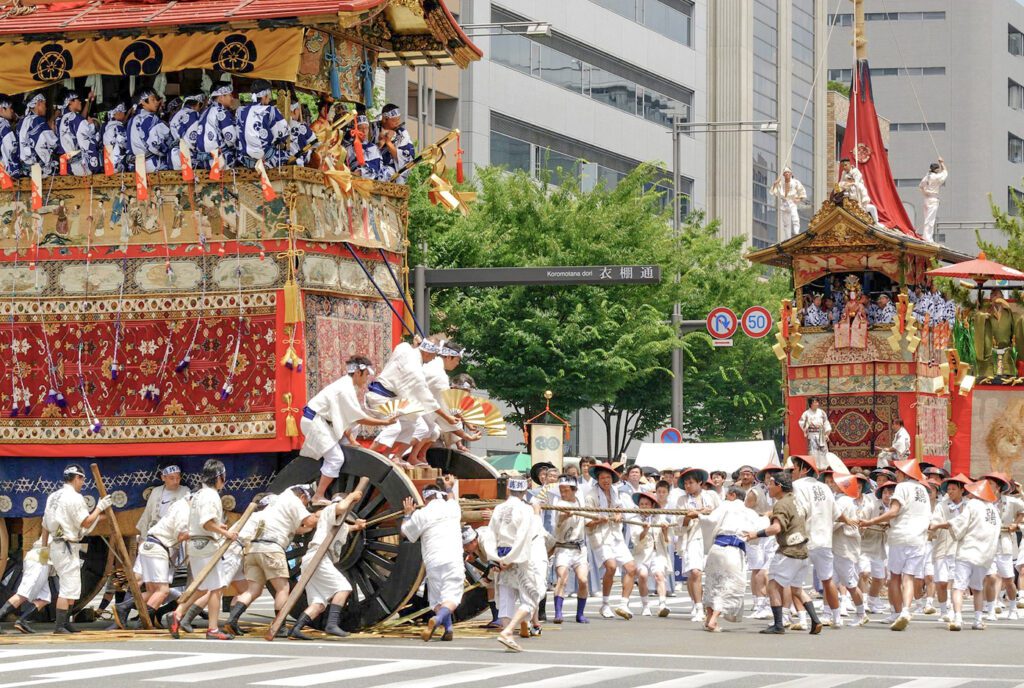
More Things to Do in Kyoto: Events and Festivals
When it was initially settled, Kyoto was modeled on the Chinese city of Chang. Ancient Chang is now Xi’an, a fascinating Chinese city home to the famed Terracotta Army.
As the population grew, hygiene became a problem, especially when the Kamo River flooded.
In those ancient times, several rituals and festivals were annually held to placate the spirits responsible for plagues and other catastrophes.
Read about Kyoto Weather and the Best Time to Visit
Many of these festivals were woven into local customs and are still observed, although there are just too many to list here. However, we found that the Japan National Tourism Organization has an outstanding list of festivals in Kyoto, updated annually. It’s a great resource if you’re planning a trip to Japan.
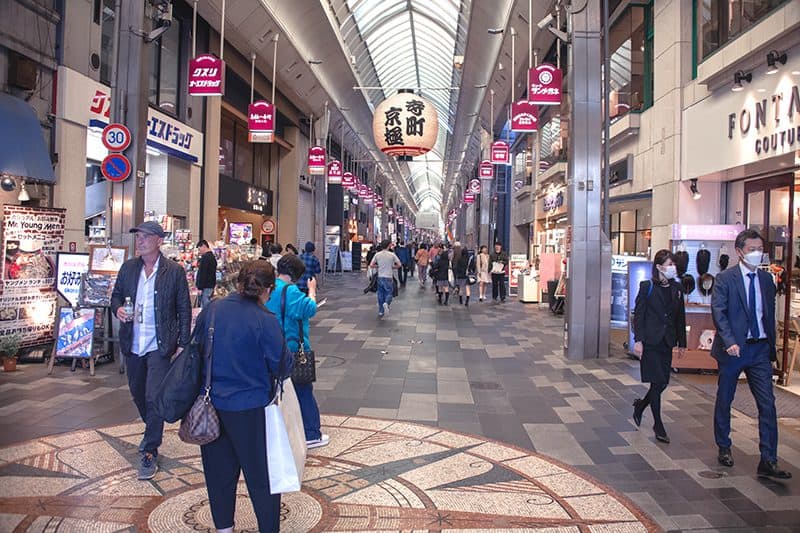
Shopping in Kyoto
Shinbashi-dori (Shinbashi Street) in the Geisha district is especially picturesque. Not far away, you’ll find a cluster of antique shops (which, unfortunately, we didn’t visit) on Furumonzen-dori and Shinmonzen-dori. Shijo-dori is more modern (and lively), with plenty of souvenir shops.
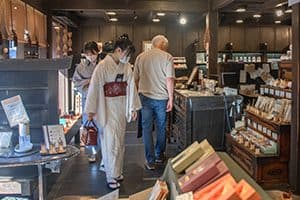
Our friends at Tauck Tours, which hosts several tours in Japan, suggest these popular shopping areas in Kyoto:
Takashimaya Mall is a large department store chain carrying many products, including designer clothes, jewelry, kimonos, pottery, lacquerware, tableware, and more. Located on Shijo Street near the Teramachi Shopping Street.
Teramachi Shopping Arcade is a series of covered pedestrian streets that offers an array of art galleries, bookshops, clothing stores, and boutiques. Here, you’ll find a wide variety of Japanese goods, from Japanese woodblock prints to teenage-oriented stores. There’s a wealth of stores where you can purchase everything from local food to the latest electronics.
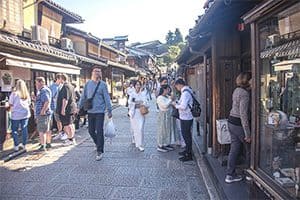
Nishiki Market: located in a side arm of the Teramachi Shopping Arcade, the Nishiki market is known as the “kitchen of Kyoto.” It features the many specialties of Kyoto, such as pickled vegetables and tofu. Most shops close around 5 or 6 pm, and many accept cash only.
Ippodo Tea Shop: this shop offers first-class teas and is considered the best in town. The store offers Matcha tea, Uji-shimizu (sweetened Matcha), hojicha (roasted green tea), genmaicha (green tea with roasted brown rice), and more.
Kyoto Handicraft Center: here, you’ll find kimonos, yukata, lacquerware, books, folding screens, hanging scrolls, and more. It has top quality of goods.
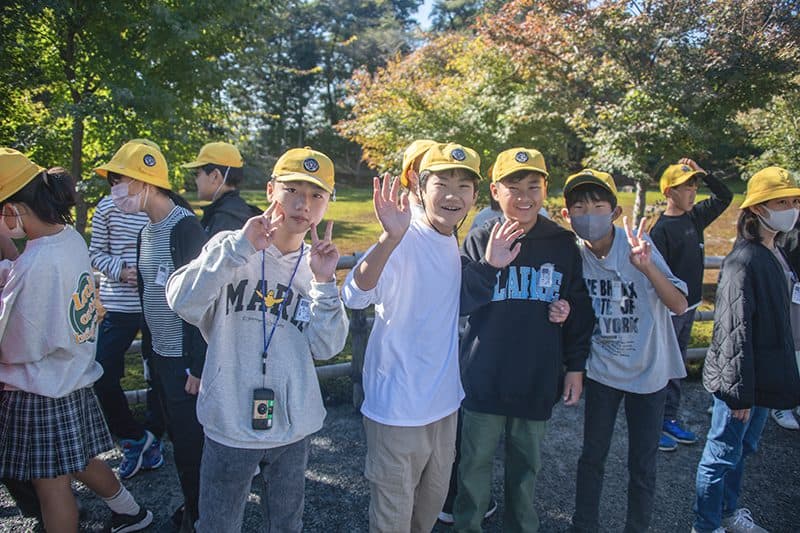
Helpful Tips and Other Info
In Japan, everything is exceptionally clean, including streets and sidewalks, public transportation, taxi cabs, public or private bathrooms, etc.
You’ll likely be surprised at all the high-tech toilets you’ll find in Japan. Motion-operated lids, heated seats, auto flush, etc. In our three weeks in Japan, we didn’t encounter a single “regular” toilet anywhere.
There are very few public bathrooms in Kyoto. If you need one while traveling, the best places to find them are in train stations, convenience stores (7-Eleven, Family Mart, Lawson), and fast-food places (McDonald’s, Starbucks). These are also the places where you’ll find public trash bins, which are rare anywhere else.
Never try to open the door of a taxi, as Jim mistakenly did. In Japan, taxi drivers open the passenger doors internally from their seats. Another plus is that you can also use credit cards in taxis.
Arrive at the airport up to three hours before your scheduled departure to clear security when returning from Japan.
Bring a comfortable pair of walking shoes, as well as a pair of slip-ons, if you’re traveling to Japan. Slip-ons make things a lot easier when you take your shoes off and put them back on multiple times a day while visiting temples and shrines.
Shrines, temples, and some shops still only accept cash; you should always have some with you. You’ll find credit-card cash machines dispensing Yen at 7-Eleven and other “family stores.”
Etiquette is very important in Japan, although the Japanese don’t expect tourists to be as conscientious about it as they are. But there are certain things you should know in advance, such as never to blow your nose in public, although sniffling is acceptable. And never stick your chopsticks upright in a bowl of rice since it’s symbolic of death and funerals.
Always swap your outdoor shoes for slippers wherever they are provided (especially in a shrine or temple). Be prepared to change those slippers again if you’re headed for the bathroom/toilet.
Never tip anyone since it is not expected and is often considered rude.

Thanks for an interesting and informative article. I am planning my first trip to Japan in August. I am excited and a little apprehensive. You just added to the excitement.
Thank you Dean. You’ll have a wonderful time. Did you see this article which we just published today: A Fascinating Upscale Tour of Japan<